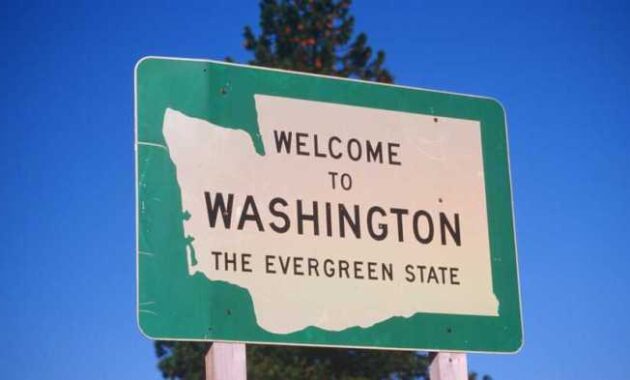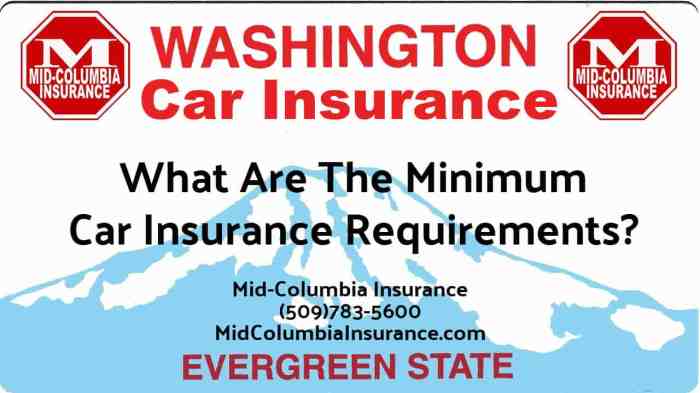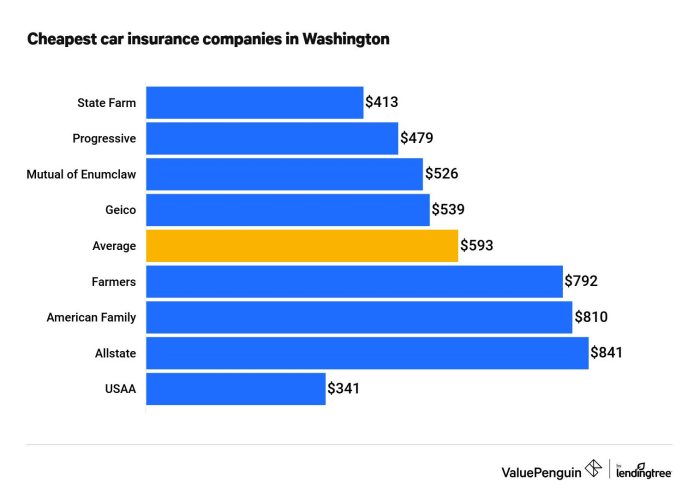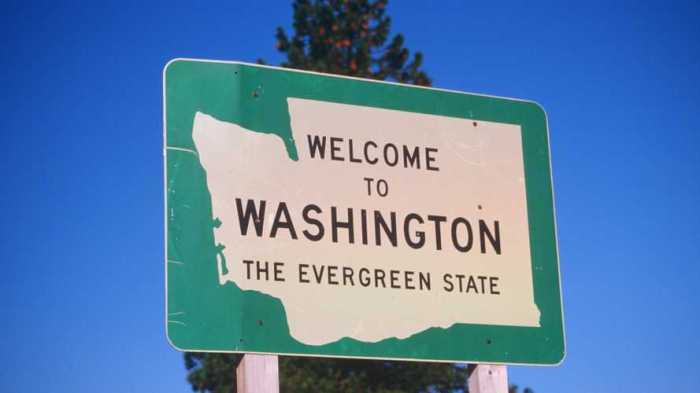
Securing the right car insurance in Washington State is crucial, balancing legal obligations with personal financial protection. Understanding the intricacies of coverage options, cost factors, and the claims process can feel overwhelming. This guide aims to demystify Washington car insurance, providing a clear and concise overview to empower you to make informed decisions.
From understanding minimum liability requirements and the impact of your driving record on premiums, to exploring various coverage types and finding the best deals, we’ll cover essential aspects of Washington car insurance. We’ll also delve into strategies for saving money and navigating the claims process should the unfortunate happen. This comprehensive resource will equip you with the knowledge to confidently manage your car insurance needs in Washington.
Washington State Minimum Insurance Requirements

Driving in Washington State requires carrying the minimum amount of car insurance mandated by law. Failure to do so can result in significant penalties, impacting your driving privileges and potentially your finances. Understanding these requirements is crucial for all drivers in the state.
Minimum Liability Coverage Amounts
Washington State requires drivers to carry minimum liability insurance coverage. This coverage protects others if you cause an accident. The minimum amounts are $25,000 for bodily injury to one person, $50,000 for bodily injury to multiple people in a single accident, and $10,000 for property damage. This means that if you cause an accident resulting in injuries or property damage, your insurance company will pay a maximum of these amounts to compensate the injured parties or repair the damaged property. It is important to note that this is the *minimum* required, and higher coverage amounts are strongly recommended to protect yourself financially in the event of a serious accident.
Penalties for Driving Without Insurance
Driving in Washington without the minimum required insurance is a serious offense. Penalties can include significant fines, suspension of your driver’s license, and even the impoundment of your vehicle. The specific penalties can vary depending on the circumstances and whether this is a first offense or a repeat offense. Furthermore, if you are involved in an accident without insurance, you could be held personally liable for all damages, potentially leading to substantial financial burdens. This can include medical bills, vehicle repairs, and lost wages for those injured in the accident.
Comparison to Neighboring States
Washington’s minimum insurance requirements are comparable to, but not identical to, those of its neighboring states, Oregon and Idaho. While a direct numerical comparison is presented in the table below, it’s important to note that the specific details of insurance laws and penalties can vary significantly between states. It’s always advisable to check the specific regulations of each state you drive in.
| State | Bodily Injury (per person) | Bodily Injury (total) | Property Damage |
|---|---|---|---|
| Washington | $25,000 | $50,000 | $10,000 |
| Oregon | $25,000 | $50,000 | $20,000 |
| Idaho | $25,000 | $50,000 | $15,000 |
Finding and Comparing Car Insurance in Washington

Securing the right car insurance in Washington can feel overwhelming, given the various options and factors to consider. Fortunately, several methods exist to simplify the process of finding and comparing quotes, allowing you to make an informed decision that best suits your needs and budget. This section will Artikel these methods, highlighting their advantages and disadvantages, and providing a practical guide to comparing quotes effectively.
Methods for Obtaining Car Insurance Quotes
Finding car insurance quotes involves several distinct approaches, each with its own strengths and weaknesses. Understanding these differences is crucial for making a well-informed choice.
- Online Comparison Tools: Websites like The Zebra, NerdWallet, and others aggregate quotes from multiple insurance providers, allowing you to compare options side-by-side. This offers convenience and a broad overview of available coverage and pricing. However, the displayed quotes may not always reflect your exact circumstances and may be subject to change upon application.
- Independent Insurance Agents: These agents represent multiple insurance companies, allowing them to shop around for the best rates and coverage on your behalf. Their expertise can be invaluable in navigating complex policy options and finding suitable coverage. The downside is that they may receive commissions from the insurers, potentially influencing their recommendations.
- Direct from Insurers: You can obtain quotes directly from individual insurance companies such as State Farm, Geico, or Progressive through their websites or by phone. This provides direct access to the insurer’s specific offerings and policies, but it requires more individual research to compare across multiple companies.
Advantages and Disadvantages of Each Method
The best method for finding car insurance depends on individual preferences and circumstances. Weighing the pros and cons is essential.
| Method | Advantages | Disadvantages |
|---|---|---|
| Online Comparison Tools | Convenient, broad comparison, quick quotes | Quotes may be estimates, less personalized advice |
| Independent Agents | Personalized advice, access to multiple insurers, potentially better rates | Commission-based, may not offer all available options |
| Direct from Insurers | Direct access to insurer policies, clear communication | Requires more research to compare across companies, potentially less personalized service |
Interpreting and Comparing Insurance Quotes
Insurance quotes often appear complex, but understanding key elements simplifies comparison. Focus on the following:
- Premium: The total cost of your insurance policy, typically paid annually, semi-annually, or monthly.
- Coverage Limits: The maximum amount the insurer will pay for a covered claim (e.g., bodily injury liability, property damage liability, uninsured/underinsured motorist coverage).
- Deductible: The amount you pay out-of-pocket before your insurance coverage kicks in.
- Discounts: Many insurers offer discounts for safe driving, bundling policies, or other factors. Compare the final price after applying all applicable discounts.
Step-by-Step Guide to Obtaining and Comparing Online Car Insurance Quotes
Finding and comparing car insurance quotes online is straightforward.
- Gather Information: Collect necessary information, including your driving history, vehicle details, and desired coverage levels.
- Use Comparison Websites: Visit multiple comparison websites and enter your information. Note that slight variations in entered data may affect quotes.
- Review Quotes: Carefully compare quotes, paying close attention to premium, coverage limits, deductibles, and discounts.
- Check Insurer Ratings: Research the financial stability and customer satisfaction ratings of the insurers offering quotes.
- Read Policy Details: Before making a decision, thoroughly review the policy details of the insurer you are considering.
- Choose and Purchase: Select the policy that best meets your needs and budget and complete the purchase process.
Filing a Claim in Washington

Filing a car insurance claim in Washington can seem daunting, but understanding the process can make it significantly smoother. This section Artikels the steps involved, from the initial accident report to receiving your settlement. Remember, prompt action and accurate documentation are key to a successful claim.
The process generally begins immediately after a car accident. Quick reporting and thorough documentation are crucial for a smoother claim process. You should contact your insurance company as soon as possible after the accident, even if the damage seems minor. Delaying the reporting can complicate the process and potentially impact your claim’s outcome.
Necessary Information for a Successful Claim
To successfully file a claim, you’ll need to gather several pieces of information. This includes details about the accident itself, such as the date, time, and location. You’ll also need information about the other driver(s) involved, including their name, contact information, driver’s license number, insurance company, and policy number. Crucially, you should obtain contact information from any witnesses to the accident. Photographs of the damage to all vehicles involved, as well as the accident scene itself, are extremely valuable. Finally, if there are any injuries, medical reports and bills will be necessary. The more comprehensive your documentation, the stronger your claim will be.
The Claim Filing Process
The steps involved in filing a claim are fairly straightforward, but attention to detail at each stage is vital. Following these steps carefully will help ensure a smooth and efficient claims process.
- Report the Accident to Your Insurance Company: Contact your insurance company as soon as possible after the accident. Provide them with a preliminary report, including the date, time, and location of the accident, and a description of what happened.
- File a Police Report (if necessary): If the accident involved injuries or significant property damage, you are generally required to file a police report. Obtain a copy of this report for your records and your insurance claim.
- Gather Necessary Information: Collect all relevant information, including contact details for all parties involved, witness information, photographs of the damage, and any medical reports.
- Complete the Claim Form: Your insurance company will provide you with a claim form. Complete this form accurately and thoroughly, providing all the information requested.
- Submit Supporting Documentation: Submit all supporting documentation, such as the police report, photographs, witness statements, and medical bills, along with the completed claim form.
- Cooperate with the Insurance Adjuster: An insurance adjuster will contact you to investigate the accident and assess the damages. Cooperate fully with the adjuster and answer all their questions honestly and promptly.
- Negotiate a Settlement (if necessary): If you disagree with the initial settlement offer, you have the right to negotiate. Keep detailed records of all communications and offers.
- Receive Payment: Once the claim is settled, you will receive payment from your insurance company. This may be a direct deposit or a check.
Ending Remarks
Successfully navigating the world of Washington car insurance requires a blend of understanding legal obligations, recognizing personal risk factors, and strategically selecting the right coverage. By carefully considering minimum requirements, influencing factors on premiums, available coverage types, and efficient comparison methods, you can secure a policy that offers both adequate protection and financial prudence. Remember to regularly review your policy and explore available discounts to ensure you maintain optimal coverage at the best possible price.
FAQs
What happens if I’m in an accident and don’t have insurance?
Driving without the minimum required insurance in Washington is illegal and will result in significant penalties, including license suspension, fines, and potential legal repercussions.
Can I get car insurance if I have a DUI on my record?
Yes, but it will likely be more expensive. Insurers consider DUIs high-risk factors and will significantly increase your premiums. Your options might be limited to high-risk insurers.
How often can I change my car insurance provider?
You can generally switch providers at any time. However, there may be penalties or fees depending on your existing policy terms. It’s best to check your policy for details.
What is Uninsured/Underinsured Motorist coverage?
This coverage protects you if you’re involved in an accident with an uninsured or underinsured driver. It covers your medical bills and property damage even if the other driver is at fault and lacks sufficient insurance.